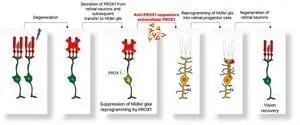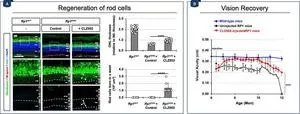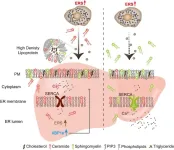(Press-News.org) Vision is one of the most crucial human senses, yet over 300 million people worldwide are at risk of vision loss due to various retinal diseases. While recent advancements in retinal disease treatments have successfully slowed disease progression, no effective therapy has been developed to restore already lost vision—until now. KAIST researchers have successfully developed a novel drug to restore vision.
< Photo 1. (From left) Ph.D. candidate Museong Kim, Professor Jin Woo Kim, and Dr. Eun Jung Lee of KAIST Department of Biological Sciences >
KAIST (represented by President Kwang Hyung Lee) announced on the 30th of March that a research team led by Professor Jin Woo Kim from the Department of Biological Sciences has developed a treatment method that restores vision through retinal nerve regeneration.
The research team successfully induced retinal regeneration and vision recovery in a disease-model mouse by administering a compound that blocks the PROX1 (prospero homeobox 1) protein, which suppresses retinal regeneration. Furthermore, the effect lasted for more than six months.
This study marks the first successful induction of long-term neural regeneration in mammalian retinas, offering new hope to patients with degenerative retinal diseases who previously had no treatment options.
As the global population continues to age, the number of retinal disease patients is steadily increasing. However, no treatments exist to restore damaged retinas and vision. The primary reason for this is the mammalian retina's inability to regenerate once damaged.
Studies on cold-blooded animals, such as fish—known for their robust retinal regeneration—have shown that retinal injuries trigger Müller glia cells to dedifferentiate into retinal progenitor cells, which then generate new neurons. However, in mammals, this process is impaired, leading to permanent retinal damage.
< Figure 1. Schematic diagram of the mechanism of retinal regeneration through inhibition of PROX1 migration. PROX1 protein secreted from retinal damaged retinal neurons transfers to Müllerglia and inhibits dedifferentiation into neural progenitor cells and neural regeneration. When PROX1 is captured outside the cells by an antibody against PROX1 and its transfer to Müllerglia is interfered, dedifferentiation of Müllerglia cells and retinal regeneration processes are resumed, restoring visual function. >
Through this study, the research team identified the PROX1 protein as a key inhibitor of Müller glia dedifferentiation in mammals. PROX1 is a protein found in neurons of the retina, hippocampus, and spinal cord, where it suppresses neural stem cell proliferation and promotes differentiation into neurons.
The researchers discovered that PROX1 accumulates in damaged mouse retinal Müller glia, but is absent in the highly regenerative Müller glia of fish. Furthermore, they demonstrated that the PROX1 found in Müller glia is not synthesized internally but rather taken up from surrounding neurons, which fail to degrade and instead secrete the protein.
Based on this finding, the team developed a method to restore Müller glia’s regenerative ability by eliminating extracellular PROX1 before it reaches these cells.
< Figure 2. Retinal regeneration and visual recovery in a retinitis pigmentosa model mouse through Anti-PROX1 gene therapy. After administration of adeno-associated virus expressing PROX1 neutralizing antibodies (AAV2-Anti-PROX1) to the eyes of RP1 retinitis pigmentosa model mice with vision loss, the photoreceptor cell layer of the retina is restored (A) and vision is restored (B). >
This approach involves using an antibody that binds to PROX1, developed by Celliaz Inc., a biotech startup founded by Professor Jin Woo Kim’s research lab. When administered to disease-model mouse retinas, this antibody significantly promoted neural regeneration. Additionally, when delivered, the antibody gene to the retinas of retinitis pigmentosa disease model mice, it enabled sustained retinal regeneration and vision restoration for over six months.
The retinal regeneration-inducing therapy is currently being developed by Celliaz Inc. for application in various degenerative retinal diseases that currently lack effective treatments. The company aims to begin clinical trials by 2028.
This study was co-authored by Dr. Eun Jung Lee of Celliaz Inc. and Museong Kim, a Ph.D. candidate at KAIST, as joint first authors. The findings were published online on March 26 in the international journal Nature Communications. (Paper Title: Restoration of retinal regenerative potential of Müller glia by disrupting intercellular Prox1 transfer | DOI: 10.1038/s41467-025-58290-8)
Dr. Eun Jung Lee stated, "We are about completing the optimization of the PROX1-neutralizing antibody (CLZ001) and move to preclinical studies before administering it to retinal disease patients. Our goal is to provide a solution for patients at risk of blindness who currently lack proper treatment options."
This research was supported by research funds from Korean National Research Foundation (NRF) and the Korea Drug Development Foundation (KDDF).
END
KAIST Develops Retinal Therapy to Restore Lost Vision
2025-04-02
ELSE PRESS RELEASES FROM THIS DATE:
Adipocyte-hepatocyte signaling mechanism uncovered in endoplasmic reticulum stress response
2025-04-02
The endoplasmic reticulum (ER) is the portion of the cell responsible for manufacturing and folding proteins. Proteins are essential for a wide range of cellular functions—as enzymes, transporters, hormones, antibodies, receptors, and more. They must be folded into the correct three-dimensional shape to function properly. If the ER is unable to manufacture or fold proteins correctly, the cell develops ER stress, which activates the unfolded protein response (UPR)—a protective mechanism aimed at restoring cellular function.
While UPR begins ...
Mammals were adapting from life in the trees to living on the ground before dinosaur-killing asteroid
2025-04-02
More mammals were living on the ground several million years before the mass extinction event that wiped out the dinosaurs, new research led by the University of Bristol has revealed.
The study, published today in the journal Palaeontology, provides fresh evidence that many mammals were already shifting toward a more ground-based lifestyle leading up to the asteroid’s impact.
By analysing small-fossilised bone fragments, specifically end of limb bones, from marsupial and placental mammals found in Western North America - the only place with a well-preserved terrestrial fossil record from this time – the team discovered signs that ...
Low LDL cholesterol levels linked to reduced risk of dementia
2025-04-01
People with low levels of low-density lipoprotein cholesterol (LDL-C) in their blood have a lower risk of dementia, including lower risk of Alzheimer’s disease related dementia, shows a study published online today in the Journal of Neurology Neurosurgery & Psychiatry.
Use of statins conveyed an additional protective effect for people with low LDL-C, specifically those with blood levels less than 1.8 mmol/L (<70 mg/dL), reducing their risk of dementia even further.
However, reducing LDL-C ...
Thickening of the eye’s retina associated with greater risk and severity of postoperative delirium in older patients
2025-04-01
Thickening of the macular layer of the eye’s retina is associated with a greater risk of postoperative delirium for older patients undergoing surgery under general anaesthetic, reveals a study published online in the open access journal General Psychiatry.
Postoperative delirium is one of the most common complications for older patients after surgery and can have profound implications for long-term health and wellbeing.
Patients with postoperative delirium require longer hospital stays and are more likely to require support at home to help with daily tasks such as washing, dressing, and eating or be discharged ...
Almost one in ten people surveyed report having been harmed by the NHS in the last three years
2025-04-01
Almost one in ten people in Great Britain experienced healthcare-related harm due to care or treatment they received from the National Health Service (NHS) or difficulties accessing care in the last three years, show the findings of a large population survey published in the journal BMJ Quality & Safety.
In more than eight out of ten cases, the harm had a moderate or severe impact on the respondent. Disadvantaged groups, including people with disabilities, long term conditions and those in lower socioeconomic groups, were ...
Enhancing light control with complex frequency excitations
2025-04-01
NEW YORK, April 1, 2025 — Researchers at the Advanced Science Research Center at the CUNY Graduate Center (CUNY ASRC) and at Florida International University report in the journal Science their insights on the emerging field of complex frequencies excitations, a recently introduced scheme to control light, sound and other wave phenomena beyond conventional limits. Based on this approach, they outline opportunities that advance fundamental understanding of wave-matter interactions and usher wave-based technologies into a new era.
In conventional light wave- and sound wave- based systems such as wireless cell phone technologies, microscopes, speakers ...
New research finds novel drug target for acute myeloid leukemia, bringing hope for cancer patients
2025-04-01
A team of scientists from The University of Texas Health Science Center at San Antonio (UT Health San Antonio) has identified a promising new drug target for acute myeloid leukemia (AML), a deadly blood cancer with a five-year survival rate of just 30%, according to the National Cancer Institute. Their study, published in Cell Stem Cell in February, highlights the crucial role of a protein called paraspeckle component 1 (PSPC1) in the progression of AML.
An aggressive blood cancer, AML originates ...
New insight into factors associated with a common disease among dogs and humans
2025-04-01
The pathogens Giardia duodenalis and Cryptosporidium are common causes of sometimes-fatal intestinal diseases in humans, other mammals and birds worldwide.
Now, findings from researchers at Texas A&M University provide new, evidence-based insight into minimizing the risk of these diseases at canine facilities.
“In adult, healthy humans and animals, these diseases usually cause diarrhea and occasionally other minor ailments, but for infants, puppies and the immunocompromised, infection could be deadly,” said Loni Taylor, PhD, DVM, an epidemiologist with the Texas A&M University School of Public Health, who led ...
Illuminating single atoms for sustainable propylene production
2025-04-01
More than 150 million metric tons of propylene are produced annually, making it one of the most widespread chemicals used in the chemical industry.
Propylene is the basis for polypropylene, a polymer used in everything from medical devices to packaging to household goods. But most propylene is produced through steam cracking, a high-energy process that uses heat to break down crude oil into smaller hydrocarbons.
Now, Northwestern University chemists have found a way to create propylene using light. Their findings show that a nanoengineered photoactive ...
New study finds Rocky Mountain snow contamination
2025-04-01
Mountain snowpacks accumulate snow throughout the winter, building up stores of water that will supply communities across the American West throughout the long dry season. Now, a new study shows that as storms carry snow to the Rocky Mountains, they are also bringing mercury and other contaminants from mines in the region. The research helps scientists understand how contaminants are spread by atmospheric circulation and has implications for snowpack preservation and illuminating the lasting environmental impact of mining activities.
The study, published in the May issue of the journal Environmental Pollution, examined contamination levels for ...





